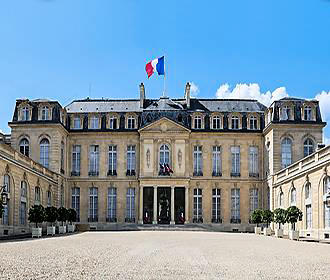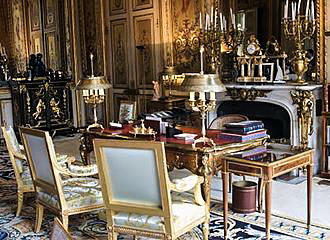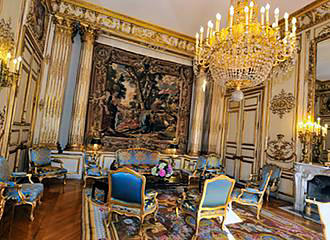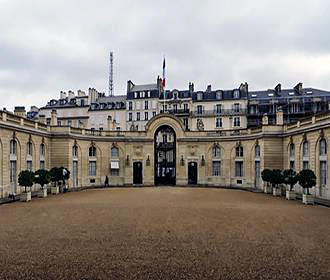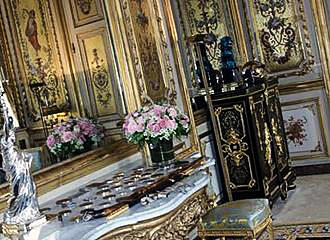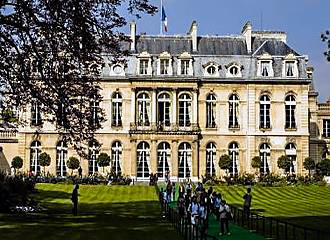Paris Palais de l’Elysee Presidential Residence
The Paris Palais de l’Elysee, or Elysee Palace for short, is the official residence of the President of the French Republic where foreign dignitaries meet, and located close to the Champs-Elysees, this heavily guarded palace has a rich history and impressive architecture.
The Beginnings of the Paris Palais de l’Elysee
Constructed by the architect Armand-Claude Mollet, the palatial mansion house was originally called the Hotel d’Evreux after the person that owned it and it was completely finished with its interior decoration by 1722.
At the time this residence was considered one of the most admired houses in Paris, so when the count d’Evreux died, King Louis XV purchased the residence for his mistress and after she died, the property went back to the crown, but by 1773 it had been purchased by a banker called Nicolas Beaujon.
This wealthy banker wanted the Hotel d’Evreux to house his collection of paintings and he hired the architect Etienne-Louis Boullee to make many different alterations to the building and transform the gardens, but it was then purchased by the Duchess of Bourbon in 1787 who then named it the Elysee.
The next stage of the Paris Palais de l’Elysee
During the French Revolution, the Paris Palais de l’Elysee, or Elysee Palace, was confiscated and then leased out, but in 1803 was sold to Joachim Murat who was Marshal of France and future King of Naples, then in 1808 it was purchased by Napoleon Bonaparte.
However, a few years later it was then returned back to the Duchess of Bourbon, who then subsequently sold the Paris Palais de l’Elysee to King Louis XVIII in 1816 and from then was starting to be used a guest residence for important foreign visitors.
Louis-Napoleon Bonaparte, known as Napoleon III, who was the ruler of the Second Empire and of the French Republic resided at this palace in Paris and made some renovations, and then Marshal Macmahon, who was the President of the Third Republic of France then made the Palais de l’Elysee the official residence of the president in the 1870s.
The Paris Palais de l’Elysee official residence of French Presidents
From this era of the Third Republic, the Paris Palais de l’Elysee became the official residence of the Presidents of France, such as President Raymond Poincare, President Paul Deschanel, etc, but was completely deserted during World War II.
It was then reoccupied by the President of the provisional government, Vincent Auriol of the fourth French Republic in 1946 and then by Rene Coty who resigned to General Charles de Gaulle, who became the first President of the Fifth Republic.
However, according to many reports, Charles de Gaulle did not like the idea that foreign state officials used to stay at the Paris Palais de l'Elysee because it was a bit too personal, and therefore the state purchased the Hotel de Marigny as the guest residence for kings and other state officials that were visiting Paris.
And yet again, according to many sources, the President Francois Mitterrand preferred to stay at his own private residence rather than the official Palais de l’Elysee, but President Jacques Chirac did reside here with his wife throughout his term in office and there was always an official Bastille Day party held within the grounds of this palace in Paris.
But when the President Nicolas Sarkozy took over, he put a stop to these festivities as a symbol of the economic crisis that France was going through, in order to reduce the financial burden, yet the palace would still be classed as the official home of the President of France.
About the Paris Palais de l’Elysee today
As you can no doubt imagine, the Paris Palais de l’Elysee is a heavily guarded mansion house and palace in Paris that has had the same role since the 1800s, as the official residence of the President of France and therefore is a place not normally open to the public.
However, if you are lucky enough to step inside and experience this wonderful mansion, you will find that there is a vast amount of different styles, where former residents have left their mark on designs, decor and their own personal tastes.
To give you an idea, there is a very exquisite and lavish ballroom that is used for official ceremonies, which dates back to the 1800s, and a library that was originally an office on the ground floor, along with a dining room that looks like it came out of the 1970s.
On the second floor are meeting rooms and even though some have been renovated, there are still the rooms with wood panelling, portraits, tapestries and much more, which are no doubt there as reminders of its heritage and past.
Of course, there are also the gardens to admire along with the facade and the fabulous entrance to the Paris Palais de l’Elysee with its monumental gate, and yet, because of its status plus its heritage, unfortunately this Paris tourist attraction is not open every day to the public.
Access to the Paris Palais de l’Elysee
Even though this mansion house is normally out of reach to the normal resident or tourist on holiday in Paris, there is an opportunity that normally only occurs once or twice a year on a national heritage day, in which to get a glimpse inside this fabulous building.
Many people find it hard to figure out when this day will happen, yet if you are one of the lucky ones, then you are in for a real treat and a place to visit that you will never forget. But do be patient waiting for queues of people to access this part of the history of Paris, that is still continuing as a legacy today.
You will find that the main entrance is on the Rue du Faubourg Saint-Honore, yet the gardens face towards the Jardins du Champs-Elysees and the famous avenue, which is how the name of the palace changed.
When it comes to Paris public transport, the nearest Metro stations are the Champs-Elysees - Clemenceau stop serving lines 1 and 13, the Franklin D Roosevelt stop serving lines 1 and 9, or the Concorde stop serving lines 1, 8 and 12.
Alternatively, the Paris bus lines 28, 32, 42, 52, 73, 80, 83 and 93 along with the Noctilien Night Bus Service via lines N01, N11 and N24 will also get you close by to these popular tourist attractions and many others that are within easy walking distance.
